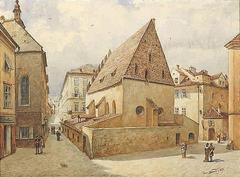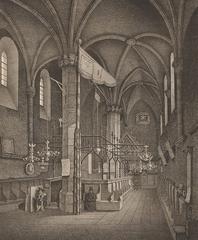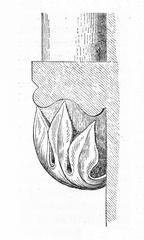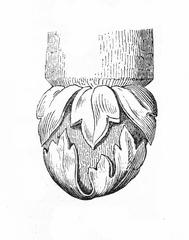
Old-New Synagogue Prague: Visiting Hours, Tickets, and Historical Significance
Date: 14/06/2025
Introduction
The Old-New Synagogue (Staronová synagoga, Altneuschul) in Prague stands as a monument of resilience, spirituality, and architectural grandeur. Dating back to 1270, it is the oldest active synagogue in Europe and the heart of Prague’s Jewish Quarter, Josefov. This remarkable structure, a masterpiece of early Gothic architecture, offers visitors an immersive journey through centuries of Jewish religious life, tradition, and legends. Whether you are a history aficionado, architecture enthusiast, or cultural traveler, the Old-New Synagogue is an essential destination in Prague.
(Jewish Museum Prague; Prague Experience)
Historical Background and Construction
Constructed around 1270 by royal stonemasons, the Old-New Synagogue is notable not only for its age but also for its robust and unique architectural design. Built amidst the growing Jewish community of medieval Prague, its original designation was simply the “New” or “Great Synagogue,” distinguishing it from even older, now-lost prayer houses. As other synagogues arose in subsequent centuries, the term “Old-New” (Altneuschul) became a fitting reflection of its enduring centrality.
Architectural Significance
The synagogue exemplifies early Gothic architecture tailored for Jewish worship. Its double-nave layout—featuring two pairs of octagonal pillars and five ribbed vault bays—is rare among synagogues of this era. The prayer hall is intentionally austere, prioritizing communal function over ornate decoration. The central bimah, encircled by an iron grille, and the eastern Torah ark (Aron Kodesh) reflect traditional liturgical arrangements. The women’s gallery, added later and accessed from outside, maintains Orthodox practice.
The building’s thick stone walls, narrow lancet windows, and small size not only echo medieval construction methods but also provided protection through centuries of unrest. Its preservation, even during the Nazi occupation when many Jewish sites were destroyed, testifies to its revered status and robust construction.
(Jewish Museum Prague; Prague Experience)
Cultural and Spiritual Role
For over 750 years, the Old-New Synagogue has been the focal point of Prague’s Jewish community. It continues to serve as a house of worship, hosting religious services, community gatherings, and significant life events. Its rabbis, especially Rabbi Judah Loew ben Bezalel (the Maharal), have shaped Jewish thought far beyond Prague’s borders. During times of persecution and hardship—including medieval pogroms, Habsburg restrictions, and the Holocaust—the synagogue has remained a symbol of Jewish perseverance and community.
(History Hit; Jewish Museum Prague)
Legends and Mystique
The Old-New Synagogue is steeped in legend. The most famous is the story of the Golem—an artificial being created from clay by Rabbi Loew to protect Prague’s Jews. According to folklore, the Golem’s remains lie hidden in the attic, which is inaccessible to the public, perpetuating the synagogue’s mystical allure.
Another enduring legend holds that the synagogue’s foundation stones were brought by angels from the ruined Temple of Jerusalem, “on condition” (Hebrew: al-tenai) they be returned when the Temple is rebuilt. These tales, while not historical fact, embody the community’s spiritual connection to the synagogue and help explain its remarkable survival.
(Synagogue.cz; praha.eu; prague.net; darkemeraldtales.com)
Rituals, Traditions, and Atmosphere
The synagogue remains an active Orthodox congregation. Visitors are asked to observe respectful conduct—men must wear head coverings (kippahs are provided), and modest dress is required. The atmosphere inside is solemn and reverent, charged with centuries of ritual and tradition. Unique customs, such as the double singing of Psalm 92 during services, are rooted in the synagogue’s legendary history.
Notable Events and Milestones
- Rabbinic Leadership: The synagogue’s rabbis, especially the Maharal, have been influential figures in Jewish intellectual and spiritual life.
- Survival Through Adversity: The building has withstood medieval pogroms, fires, and survived the Holocaust as part of a protected heritage complex.
- Modern Preservation: Ongoing restoration ensures its continued use and accessibility for future generations.
- UNESCO Recognition: The synagogue is part of the UNESCO-listed historic center of Prague, emphasizing its universal value.
Visitor Information
Location and Getting There
Situated at Maiselova 18 in Josefov, Prague’s Jewish Quarter, the synagogue is a short walk from Old Town Square and accessible by metro (Staroměstská, Line A) and tram (lines 17, 18).
Opening Hours (2025)
- January 2 – March 31: 9:00–17:00
- April 1 – October 18: 9:00–18:00
- October 19 – December 31: 9:00–17:00
- Closed: Saturdays (Shabbat) and major Jewish holidays; synagogue closes one hour before Shabbat on Fridays.
For up-to-date times, consult the official calendar.
Tickets and Admission
- Combined Jewish Quarter Ticket: CZK 600 (approx. €24) in 2025; includes the Old-New Synagogue, Old Jewish Cemetery, Spanish Synagogue, Maisel and Pinkas Synagogues.
- Discounts: Free entry with the Prague City Card; reduced rates for children, students, and seniors.
- Purchase: At Jewish Museum ticket offices or online.
Guided Tours
Guided walking tours are available Sunday to Friday at 10:30 (excluding Jewish holidays), lasting 2.5–3 hours. Tours cover the synagogue and other key sites in the Jewish Quarter and must be booked in advance due to limited group sizes.
Dress Code and Conduct
- Men: Head covering required (kippahs provided).
- All Visitors: Modest dress (shoulders and knees covered).
- Photography: Generally prohibited inside.
- Behavior: Silence and respectful conduct, especially during services.
Accessibility
Due to medieval architecture, accessibility is limited—there are steps at the entrance and no elevators. The women’s gallery is at ground level but accessed via narrow corridors. Contact the Jewish Museum Information Centre for assistance.
Nearby Attractions
- Old Jewish Cemetery: One of Europe’s oldest, adjacent to the synagogue.
- Spanish Synagogue: Noted for its Moorish Revival design.
- Maisel and Pinkas Synagogues: Feature Jewish history and Holocaust exhibitions.
- Jewish Museum in Prague: Houses extensive collections and resources.
All are within walking distance and included in the combined ticket.
(prague-now.com; View from Prague)
Practical Tips
- Best Time to Visit: Early mornings or weekdays to avoid crowds.
- Tickets: Book in advance during peak seasons.
- Guided Tours: Enhance your experience with historical context and legends.
- Respect: Observe synagogue rules and religious customs.
- Facilities: Restrooms and cloakrooms are available in the museum complex, not inside the synagogue.
(prague-now.com; Prague Experience)
Frequently Asked Questions (FAQ)
Q: What are the Old-New Synagogue’s opening hours?
A: Hours vary by season; generally 9:00–17:00 or 9:00–18:00. Closed Saturdays and Jewish holidays. Always check the official website for updates.
Q: How much is admission?
A: Included in the Jewish Quarter combined ticket (CZK 600 in 2025); discounts available.
Q: Is the synagogue accessible for visitors with mobility issues?
A: Accessibility is limited due to stairs and narrow corridors; contact the museum for details.
Q: Can I take photographs inside?
A: Photography is generally prohibited inside.
Q: Are guided tours available?
A: Yes, tours operate Sunday to Friday at 10:30. Booking in advance is advised.
Q: Is the Golem’s attic accessible?
A: No, the attic is closed to the public.
Conclusion
A visit to the Old-New Synagogue is a journey into the heart of Prague’s Jewish heritage, offering a rare blend of architectural beauty, spiritual depth, and legendary mystery. Its continued use as a house of worship, coupled with its remarkable survival through centuries of adversity, make it a unique and moving experience. By planning ahead—respecting visiting hours, ticketing, dress code, and customs—you can fully appreciate the profound history and vibrant life of this unparalleled site. Enhance your exploration through guided tours or audio guides, and consider visiting the nearby Jewish heritage sites for a comprehensive understanding of Prague’s rich past.
For more information and to plan your visit:


























































































































































































